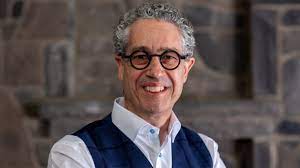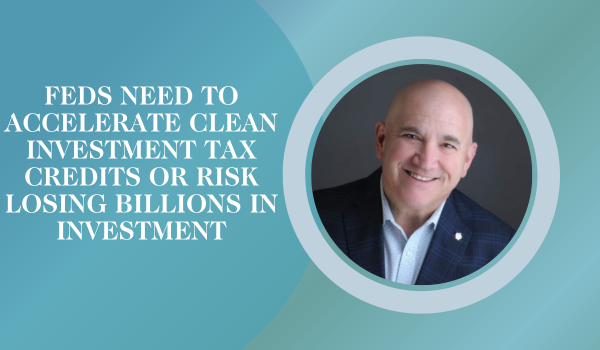Canada needs national discussion on achieving clean energy transition as a united country
Canadians need a national discussion on how to achieve the clean energy transition as a unified nation rather than as competitive adversaries, say a top energy expert and a successful venture capitalist.
The real challenge in achieving a net-zero economy is not technology but people’s behaviour and lack of critical thinking, Peter Tertzakian and Mark Blackwell told the Canada Foundation for Innovation’s (CFI) 26th annual public meeting, held at the University of Calgary and online.
 “We need to get people to think more responsibly about the consequences of their behaviour,” said Tertzakian (photo at right), deputy director of ARC Energy Research Institute and author of several books, including A Thousand Barrels a Second and The End of Energy Obesity.
“We need to get people to think more responsibly about the consequences of their behaviour,” said Tertzakian (photo at right), deputy director of ARC Energy Research Institute and author of several books, including A Thousand Barrels a Second and The End of Energy Obesity.
Most people are incredibly tired of the vitriol and polarization and being told what to do, he said. “People just actually want to talk rationally.”
Canada is too small a country to be competitive with one another, whether it’s East Coast versus West Coast, Alberta versus Ottawa, or Calgary versus Edmonton, said Blackwell (photo at left), Calgary-based general partner at Builders VC, a $500- million international investment firm in Silicon Valley.
million international investment firm in Silicon Valley.
“I would just love to see us stand together and tackle this [energy transition] as a country,” added Blackwell, who’s also board chair of the $100-million Opportunity Calgary Investment Fund.
Roseann O’Reilly Runte (photo at right), president and CEO of CFI, engaged the two thought leaders in a discussion on “Research in energy and high-tech: Driving the new sustainable economy.”
Blackwell said there are economic factors, including commodity price cycles, that are unique to and independently drive the energy and high-tech sectors. But both sectors have played and still do play a symbiotic role together, he said, pointing to the development of Alberta’s oil sands as an example.
The provincial government in 1974 created the Alberta Oil Sands Technology and Research Authority (AOSTRA), a Crown corporation, to develop the oil sands industry. But the effort required both technological advancements and supportive economic policy led by then-premier Peter Lougheed – including a $100-million provincial investment in AOSTRA.
“Now more than ever the two worlds are colliding. I don’t think you could ever think about energy without having technology embedded inside of it,” Blackwell said.
For example, about $71 billion of capital was deployed in climate technology last year, compared with about $20 billion two decades ago, he noted. Over the past decade, more than $100 billion in technology investments have been made in Canada’s energy sector.
Venture capital is being invested in disruptive, frontier technologies such as direct air capture (which captures carbon directly from the air) and nuclear fusion energy, Blackwell said. But work also is being done to improve energy and business efficiencies, such as using ChatGPT to make an entire sales team more productive and efficient.
Tertzakian described his “asymmetry-based principle,” which illustrates how inefficient current energy systems are from beginning to end. For coal-fired electricity, one pound (about 0.45 kilogram) out of 100 pounds of coal actually ends up being used to light homes. Out of 100 barrels of oil, about 12 barrels are used to fuel a vehicle.
“There’s tremendous asymmetry and that’s not good news societally, and certainly not good news given we’re still 80-plus per cent fossil fuel dependent in the world,” he said.
However, energy conservation and consumer behaviour can have huge leverage on the energy system, Tertzakian said. “If we can improve the [energy] efficiency by only a few percentage points along the journey of a joule of energy from a primary source [to its end use], we do society a tremendous service.”
Decisions made at the kitchen table and the boardroom table – and how those decisions are made – are the limiting factors in using energy more efficiently and reducing emissions, Tertzakian said.
Those kitchen-table decisions, for example, might include deciding to limit a family’s vehicles to one car – perhaps an electric vehicle. Or deciding to use public transit or ride a bicycle instead of taking the car whenever possible. Or getting more insulation, triple-glazed windows and an energy-efficient furnace for your home – perhaps even solar panels on the roof.
North American society has gone too far in emphasizing a STEM-based approach to solving big challenges such as climate change, said Tertzakian, who himself is trained in the STEM (science, technology, engineering, mathematics) area. He said if he had only $100 to spend on improving the current situation, he’d spend $60 of it on behavioural science “so people make better, more responsible decisions. That’s where the issue is.”
Canadians must work together, given the enormity of the clean energy transition
Canadians need to recognize that the country was built on natural resources and still has a resource-based economy, Tertzakian said. “But in the last certainly 20 years – amplified in the last 10 – we seem to villainize ourselves as being a resource economy.”
He noted that approximately $1.9 trillion has been invested in Canada’s oil and gas infrastructure, about 70 per cent of this financed by the U.S.
Canada’s clean energy transition will require – among other things – building a national clean electricity grid that’s two to three times the size of the existing grid. The private sector in Canada and the federal and provincial governments can’t afford to fund the energy transition, so where will the money come from, Tertzakian asked.
“Private capital is not coming here, because we have an identity crisis as to what we do and what we’re good at when it comes to natural resources,” he said.
“We need to have an honest conversation in this country about how we make decisions, how we overcome polarization, and how we become proud of what we have historically done well and can do well again.”
The U.S. Inflation Reduction Act (IRA) offers such generous incentives, Canadian pools of capital are financing clean energy projects in the U.S., Tertzakian and Blackwell said. About $400 billion in capital is being deployed through the IRA, coupled with $394 billion of private incentives and $43 billion of consumer incentives for electric vehicles and related technologies.
“That is setting the bar and standard. If we continue to work in silos – provinces, organizations, cities – we’re not going to get anywhere,” Blackwell said.
Canada also faces huge labour challenges, including an aging and retiring workforce and enrollments at trade schools at an all-time low, he said. “Talent is going to be the No. 1 issue.”
His Builders VC firm is making huge investments in robotics, including in kits to retrofit large-scale mining and construction trucks to make them self-driving and fully autonomous. Imperial Oil now has 81 bitumen-hauling trucks running autonomously at its Kearl oil sands mine near Fort McMurray, for example.
There’s ample early-stage capital available in Canada, including from the Business Development Bank of Canada, Strategic Innovation Fund, Sustainable Development Technology Canada, the global innovation clusters, the Canada Growth Fund, and other organizations, Blackwell said. “There’s more than enough sufficient resources at the front end of the funnel.”
Canada has strengths in artificial intelligence and quantum research and quantum computer development, but has a long-standing problem in being able to scale companies and keep them in Canada, Blackwell said. The country should pick a couple of select opportunities in areas it excels at to build on and become a global leader in these areas, he added.
Canada has no future without investing in research
During the annual meeting, CFI reported on its accomplishments of the past year and its financials.
Dr. Ingrid Pickering, PhD, chair of CFI, said the organization drafted a new five-year (2023-2028) strategic plan titled “Aiming High.” CFI also delivered the results of the 2023 Major Science Initiatives Fund competition, as well as the first competition of the Biosciences Research Infrastructure Fund, and administered the 2023 Innovation Fund competition.
By the end of the fiscal year on March 31, 2023, CFI’s board of directors had approved 553 projects with nearly $290 million in capital funding from CFI. In addition, CFI awarded $66 million for infrastructure operating and maintenance costs, and $635 million was awarded through the Major Science Initiatives Fund.
CFI also did studies looking at the scope of its investments in the area of climate change and environmental sustainability, and the scientific and environmental impacts and benefits of these investments.
“We continue to engage with the global research infrastructure community,” Pickering said, through CFI’s involvement on the International Conference on Research Infrastructures, held in Brno in the Czech Republic.
CFI also convened a national conference to highlight the importance of science literacy, communications and skills for young Canadians.
Runte noted that CFI received a clean audit report, from Ernst & Young, for the 26th year in a row. CFI currently has cash and cash equivalents of $203 million, all committed to funding projects, and $387 million disbursed in grants to institutions.
Runte said CFI joined the Association of Francophone Universities in the World, to help build a better network for CFI’s French researchers in Canada. CFI also joined the Belmont Forum, which brings global north and south countries together to work on environmental issues and the United Nations’ sustainable development goals.
CFI also partnered with Labs Canada to bring together its lab space and CFI-funded equipment and university researchers who need space and equipment. CFI also is working with Digital Alliance of Canada on solutions to store, find and analyze the huge amounts of data required for research.
Runte said that as part of its new strategic plan, CFI will focus on creating more core facilities that can be used by both the public and private sectors.
“We have to invest in research,” she said. “If we don’t have science and we don’t have research, there is no future for this country.”
R$
Events For Leaders in
Science, Tech, Innovation, and Policy
Discuss and learn from those in the know at our virtual and in-person events.
See Upcoming Events
You have 0 free articles remaining.
Don't miss out - start your free trial today.
Start your FREE trial Already a member? Log in
By using this website, you agree to our use of cookies. We use cookies to provide you with a great experience and to help our website run effectively in accordance with our Privacy Policy and Terms of Service.




